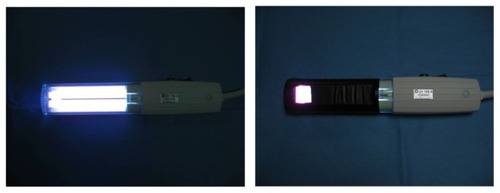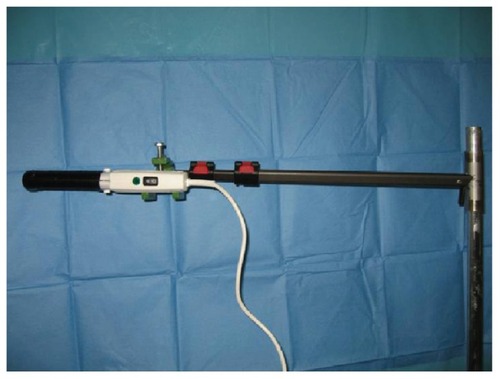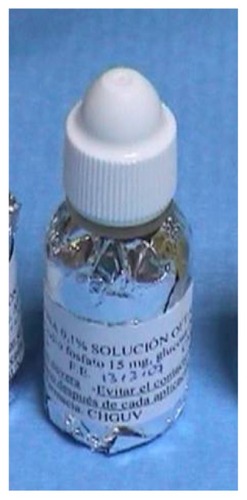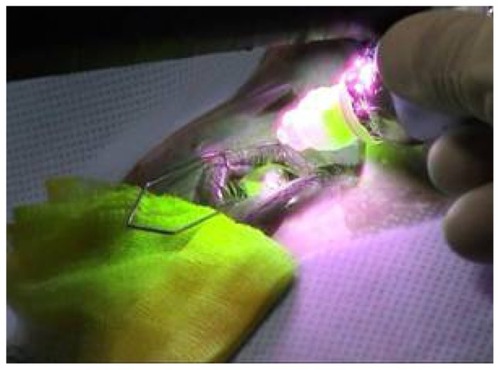Abstract
In this paper, we describe an original, affordable, and available device for performing collagen crosslinking. This is carried out in a safe and reproducible way by means of a simple modification to an affordable ultraviolet A lamp and by preparing riboflavin 0.1% solution inhouse.
Introduction
In recent years, corneal specialists have shown a fast growing interest in collagen crosslinking using the photosensitizer riboflavin and ultraviolet A light as a new therapeutic alternative for the treatment of progressive keratoconus. The aim of this treatment is to modify the biomechanical properties of the cornea, thus increasing its rigidity and preventing the progression of keratoconus.Citation1 Promising results have been published recently, and data from the Dresden clinical study have shown stabilization of the disease, even after 5 years.Citation2,Citation3
It is necessary to follow strict treatment settings and patient eligibility criteria to avoid serious ocular side effects. The patient’s cornea must be irradiated with a small peak-like sector of the ultraviolet A spectrum (370 nm) with 3 mW/cm2 irradiance for 30 minutes, which corresponds to a dose of 5.4 J/cm2.Citation3 The ultraviolet A irradiance must be checked before each treatment using an ultraviolet A meter to ensure that the optimal irradiance dose is delivered. The photosensitizing riboflavin 0.1% solution must be applied 5 minutes before irradiation and every 5 minutes during irradiation. It is also essential to perform preoperative pachymetry on each patient to exclude those with extended areas of less than 400 μm of stromal thickness.
We describe how to perform collagen crosslinking in the protocol setting using a slightly modified ultraviolet A dermatological lamp and preparing the riboflavin 0.1% solution inhouse. The cost of the treatment is lower, while maintaining its safety and efficacy.
Materials and methods
We used a slightly modified 370 nm ultraviolet A lamp (UV 109A, Waldmann, Villingen-Schwenningen, Germany) designed for dermatological treatment (), covered with a black plastic adhesive tape leaving a small window through which ultraviolet light can reach the cornea (). The desired irradiance of 3 mW/cm2 is tested with a ultraviolet A meter (Waldmann) before each treatment, thus establishing the optimal distance from the ultraviolet A lamp to the cornea. This distance was 3.5 cm with the ultraviolet A lamp we used. The lamp was held by a clamp mounted on an intravenous pole (). Patients’ corneas were irradiated with 3 mW/cm2 of ultraviolet A (370 nm) for 30 minutes.
Figure 1 Alternative device for collagen crosslinking. (A) A 370 nm ultraviolet A lamp designed for dermatological treatment. (B) The ultraviolet A lamp is covered with a black plastic adhesive tape that leaves a small window through which ultraviolet light can reach the cornea.

The riboflavin 0.1% solution was prepared just before treatment by mixing 10 mg of riboflavin-5-phosphate (Guinama, Valencia, Spain) with 10 mL of dextran 20% solution. The solution was introduced into an empty 15 mL balanced salt solution bottle (Alcon Laboratories, Fort Worth, TX, USA) wrapped in aluminum foil to avoid exposure of the riboflavin to ambient light () through a 0.22 μm sterilization filter (Millipore Corporation, Bedford, MA, USA). The entire process was performed under sterile conditions. The riboflavin 0.1% solution was applied 5 minutes before irradiation and every 5 minutes during irradiation.
Results
Thus far, we have successfully treated 12 patients with progressive keratoconus using this ultraviolet A lamp and riboflavin 0.1% solution () prepared inhouse. Visual acuity remained stable in all cases after 6 months. Stabilization of corneal topography was observed in all patients after 6 months. No side effects were detected in the early postoperative period or after 6 months.
Discussion
We have developed an alternative possibility for collagen crosslinking. The modifications needed to the ultraviolet A lamp were simple and easy to perform. The riboflavin solution was also easily prepared in the clinical pharmacy of the hospital by trained personnel. One important issue to be mentioned is the fact that the limbus should be protected against irradiation, and a round 8 mm hole in the tape that covers the lamp could be made for this purpose.
The price of a commercially available ultraviolet A lamp designed for collagen crosslinking is approximately €15,000, and the riboflavin solution prepared inhouse costs approximately €60 per patient. The price of the slightly modified ultraviolet A dermatological lamp we used is approximately $400, the riboflavin 0.1% solution we prepared inhouse costs $2.20 per patient, and the ultraviolet light meter price costs around $200. This provides ophthalmologists worldwide with an affordable alternative device for collagen crosslinking, especially for those in developing countries or places where resources are limited.
Disclosure
The authors report no conflicts of interest in this work.
References
- WollensakGCrosslinking treatment of progressive keratoconus: new hopeCurr Opin Ophthalmol200617435636016900027
- CaporossiABaiocchiSMazzottaCTraversiCCaporossiTParasurgical therapy for keratoconus by riboflavin-ultraviolet type A rays induced cross-linking of corneal collagen: preliminary refractive results in an Italian studyJ Cataract Refract Surg200632583784516765803
- WollensakGSpoerlESeilerTRiboflavin/ultraviolet A-induced collagen crosslinking for the treatment of keratoconusAm J Ophthalmol2003135562062712719068


